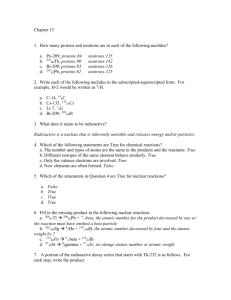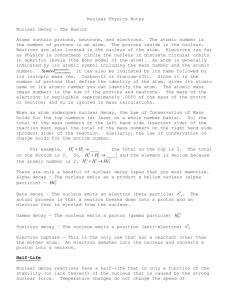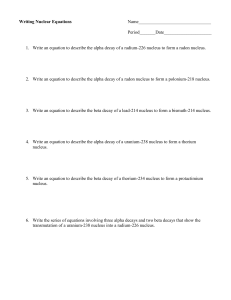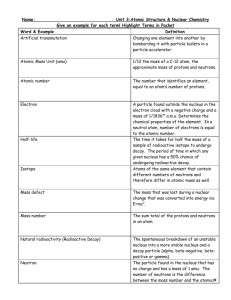Critical Thinking Questions
advertisement
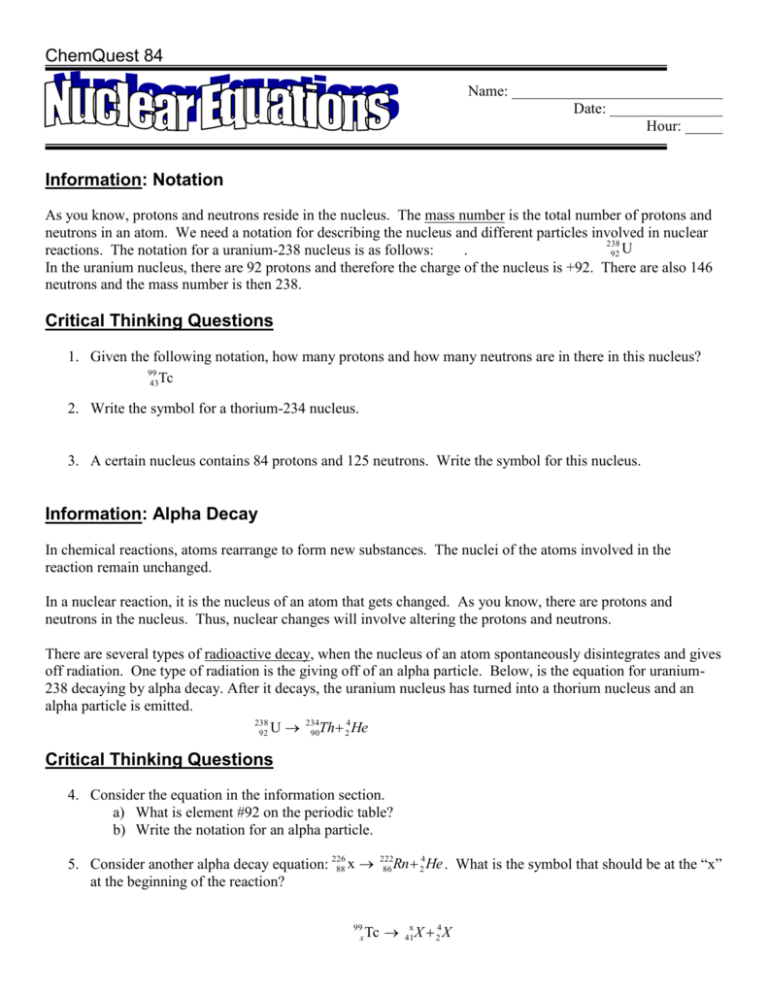
ChemQuest 84 Name: ____________________________ Date: _______________ Hour: _____ Information: Notation As you know, protons and neutrons reside in the nucleus. The mass number is the total number of protons and neutrons in an atom. We need a notation for describing the nucleus and different particles involved in nuclear 238 reactions. The notation for a uranium-238 nucleus is as follows: . 92 U In the uranium nucleus, there are 92 protons and therefore the charge of the nucleus is +92. There are also 146 neutrons and the mass number is then 238. Critical Thinking Questions 1. Given the following notation, how many protons and how many neutrons are in there in this nucleus? 99 43Tc 2. Write the symbol for a thorium-234 nucleus. 3. A certain nucleus contains 84 protons and 125 neutrons. Write the symbol for this nucleus. Information: Alpha Decay In chemical reactions, atoms rearrange to form new substances. The nuclei of the atoms involved in the reaction remain unchanged. In a nuclear reaction, it is the nucleus of an atom that gets changed. As you know, there are protons and neutrons in the nucleus. Thus, nuclear changes will involve altering the protons and neutrons. There are several types of radioactive decay, when the nucleus of an atom spontaneously disintegrates and gives off radiation. One type of radiation is the giving off of an alpha particle. Below, is the equation for uranium238 decaying by alpha decay. After it decays, the uranium nucleus has turned into a thorium nucleus and an alpha particle is emitted. 238 234 4 92 U 90Th 2 He Critical Thinking Questions 4. Consider the equation in the information section. a) What is element #92 on the periodic table? b) Write the notation for an alpha particle. 5. Consider another alpha decay equation: 226 88 x at the beginning of the reaction? 99 x Rn 24He . What is the symbol that should be at the “x” 222 86 Tc x 41 X 24 X 6. Consider yet another alpha decay equation: . Rewrite the equation without any x’s. Fill in the proper numbers or letters to make the equation complete. 7. You should be able to make a generalized rule about the atomic numbers involved in radioactive decay. Compare the sum of the atomic numbers on the left and right side of the equation. Do the same for the mass numbers. What do you see? Information: Other Particles Nuclei may give off other particles besides alpha particles. Some of the particles have mass numbers and charges and other particles do not. A table listing some particles is given below: Name of Particle Proton Notation 1 1 1 H or 1 p Neutron Electron (or “Beta”) Positron 1 0 0 1 0 1 n e or e or 0 1 0 1 Critical Thinking Questions 8. Consider the following nuclear decay: 140 55 Cs Ba 10 e 140 56 a) What kind of radioactive decay is this? b) What do you notice about the sums of the atomic numbers on the left and right sides of the equation? 9. Write the equations for several different kinds of nuclear decay of: 223 87 Fr a) beta decay: b) positron decay: c) alpha decay: 10. Consider an uranium-238 that goes through two consecutive decays. First, it emits an alpha particle. Then it emits a beta particle emission. Write the two equations and the symbol for the nucleus after the final decay. Information: Types of decay There are five common types of decay: alpha (), beta (), positron (+), electron capture (EC) and gamma () emission. The first three we have already looked at. Electron capture and gamma emission are a little different. Electron capture (often abbreviated EC) is when an unstable nucleus picks up an electron from an inner orbital of an atom. According to nuclear equations, when the electron collides with a proton, a neutron is formed: 1 0 1 1 p 1 e 0 n Notice once again that the sum of the atomic numbers on the left equals the sum on the right. The same is true of sum of the mass numbers. Here’s an example equation of what happens to the nucleus when a proton is converted to a neutron during electron capture: 40 0 40 19 K 1 e 18 Ar Gamma emission is a little different. In gamma decay, a gamma photon is released. Often gamma emission occurs very quickly after radioactive decay. The product nucleus is simply a lower-energy state of the original nucleus—there is no change in atomic number or mass number. Critical Thinking Questions 11. Write an electron capture equation for 42 20 Ca 12. What is the final symbol for the nucleus formed by another alpha, followed by an electron capture? 209 84 Po after it undergoes alpha decay, then beta, then ChemQuest 85 Name: ____________________________ Date: _______________ Hour: _____ Information: Predicting Types of Radioactive Decay Atoms are stable when they have the right numbers of protons and neutrons. By looking at the average atomic mass for an atom on the periodic table, you can see how many protons and neutrons a stable nucleus has. For example, consider carbon. The average atomic mass is 12.01. Therefore, a carbon atom with 6 protons and 6 neutrons (carbon-12) is predicted to be stable since the mass number of 12 is close to the average atomic mass on the periodic table. However, carbon-14, which has 6 protons and 8 neutrons is not stable because 14 is too far from 12. The following table is does not contain official rules, but guidelines. Types of radioactive decay: Alpha Emission Beta Emission When this type of decay occurs: When the atomic number is greater than 83. When the atom appears to have too many neutrons. Positron emission Or Electron Capture When the atom appears to not have enough neutrons. Notice that you cannot predict perfectly. For example, an atom that does not have enough neutrons will decay by positron emission or electron capture but we won’t know which one until we confirm it in the laboratory. Again, consider carbon-14. It has an unstable nucleus. It won’t decay by alpha emission because the atomic number isn’t greater than 83. Will it decay by beta emission or positron/electron capture? Critical Thinking Questions 47 1. Consider 20 Ca . a) Look at calcium on the periodic table, does the calcium-47 nucleus have too many or too few neutrons? b) Predict the type of decay and write the reaction. (Note: if you predict positron emission or electron capture, then you need to write BOTH reactions.) 2. Now consider aluminum-25. Predict the type of decay and write the reaction. (Again, if you predict positron emission or electron capture, then you need to write BOTH—do it that way for the rest of this worksheet.) 3. Predict the type of decay and write the reaction for each of the following nuclei: a) sodium-26 b) francium-223 c) niobium-140 d) iron-60 e) potassium-35 Information: Transmutation? “Transmutation” is what the alchemists were trying to accomplish. They wanted to change lead into gold. They were trying all kinds of chemical reactions in an attempt to accomplish this feat. It is impossible to accomplish transmutation using with chemical reactions. Strangely enough, however, it is possible with nuclear reactions. Just about every nuclear reaction you have written so far ends up in a transmutation: a nucleus of one atom changing into a nucleus of a different atom. Scientists can accomplish transmutation by using nuclear bombardment reactions. In the following reaction, nitrogen-14 is bombarded with alpha particles: 14 7 N 24He 178 O 11H There’s a special abbreviated notation for this reaction: 147 N (, p) 178 O . The notation tells us that an alpha particle () is transformed to a proton (p) after it bombards the nitrogen nucleus, which is turned into an oxygen-17 nucleus. Here’s another reaction and abbreviated notation: 27 13 27 13 Al(, n)30 15 P . Here, a neutron (n) is produced: 30 Al 24 He 15 P 01n Critical Thinking Questions 4. Given the following abbreviated notations, complete the abbreviated notations and then write the nuclear reactions: a) 28 14 Si (, p) ? X ? b) ?? X (, n)197 79 Au



